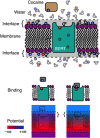Leading the charge
- PMID: 29877799
- PMCID: PMC5991830
- DOI: 10.7554/eLife.37910
Leading the charge
Abstract
A simple label-free method uses the electrical properties of cells to detect how ligands bind to membrane proteins.
Keywords: cocaine; electrophysiology; human; human serotonin transporter; membrane capacitance; molecular biophysics; serotonin; structural biology; surface charge.
© 2018, Plested.
Conflict of interest statement
AP No competing interests declared
Figures

Comment on
-
A label-free approach to detect ligand binding to cell surface proteins in real time.Elife. 2018 Apr 26;7:e34944. doi: 10.7554/eLife.34944. Elife. 2018. PMID: 29697048 Free PMC article.
References
Publication types
MeSH terms
Substances
Grants and funding
LinkOut - more resources
Full Text Sources
Other Literature Sources

